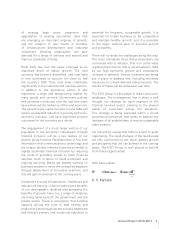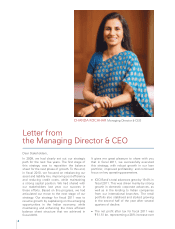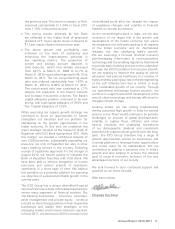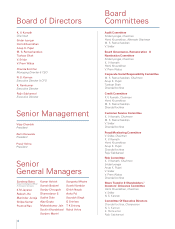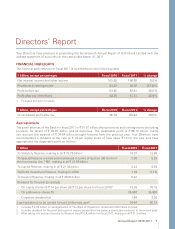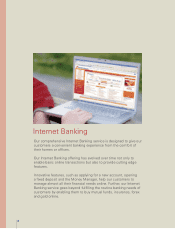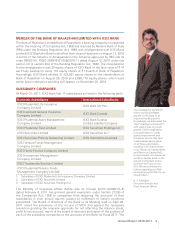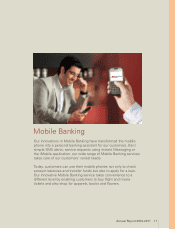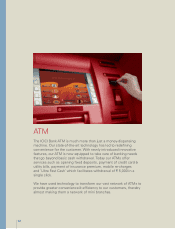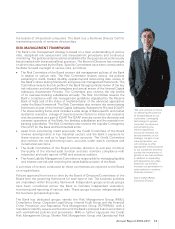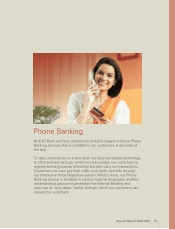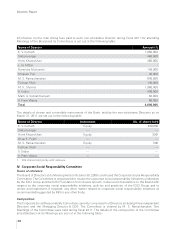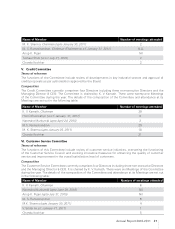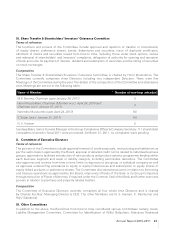ICICI Bank 2011 Annual Report Download - page 15
Download and view the complete annual report
Please find page 15 of the 2011 ICICI Bank annual report below. You can navigate through the pages in the report by either clicking on the pages listed below, or by using the keyword search tool below to find specific information within the annual report.
“We will continue to focus
on delivering the promise
of Khayaal Aapka to our
customers. Leveraging
technology for greater
customer convenience,
and enhancing the
service experience
across all channels will
be key elements of our
strategy. As part of our
value proposition, we
will continue to offer
appropriate credit products
to our customers and thus
sustain the momentum of
growth in our loan portfolio.
In addition to expanding
and deepening our urban
franchise, we will also
increase our penetration in
rural markets to enhance
financial inclusion.”
RAJIV SABHARWAL
Executive Director
the boards of 34 assisted companies. The Bank has a Nominee Director Cell for
maintaining records of nominee directorships.
RISK MANAGEMENT FRAMEWORK
The Bank’s risk management strategy is based on a clear understanding of various
risks, disciplined risk assessment and measurement procedures and continuous
monitoring. The policies and procedures established for this purpose are continuously
benchmarked with international best practices. The Board of Directors has oversight
on all the risks assumed by the Bank. Specific Committees have been constituted to
facilitate focused oversight of various risks, as follows:
•The Risk Committee of the Board reviews risk management policies of the Bank
in relation to various risks. The Risk Committee reviews various risk policies
pertaining to credit, market, liquidity, operational and outsourcing risks, review of
the Bank’s stress testing framework and group risk management framework. The
Committee reviews the risk profile of the Bank through periodic review of the key
risk indicators and risk profile templates and annual review of the Internal Capital
Adequacy Assessment Process. The Committee also reviews the risk profile
of its overseas banking subsidiaries annually. The Risk Committee reviews the
Bank’s compliance with risk management guidelines stipulated by the Reserve
Bank of India and of the status of implementation of the advanced approaches
under the Basel framework. The Risk Committee also reviews the stress-testing
framework as part of the Internal Capital Adequacy Assessment Process (ICAAP).
The stress testing frame work included a wide range of Bank-specific and market
(systemic) scenarios. Linkage of macroeconomic factors to stress test scenarios
was documented as a part of ICAAP. The ICAAP exercise covers the domestic and
overseas operations of the Bank, the banking subsidiaries and the material non-
banking subsidiaries. The Risk Committee also reviews the Liquidity Contingency
Plan (LCP) for the Bank and the threshold limits.
•Apart from sanctioning credit proposals, the Credit Committee of the Board
reviews developments in key industrial sectors and the Bank’s exposure to
these sectors as well as to large borrower accounts. The Credit Committee
also reviews the non-performing loans, accounts under watch, overdues and
incremental sanctions.
•The Audit Committee of the Board provides direction to and also monitors
the quality of the internal audit function and also monitors compliance with
inspection and audit reports of RBI and statutory auditors.
•The Asset Liability Management Committee is responsible for managing liquidity
and interest rate risk and reviewing the asset-liability position of the Bank.
A summary of reviews conducted by these committees are reported to the Board
on a regular basis.
Policies approved from time to time by the Board of Directors/Committees of the
Board form the governing framework for each type of risk. The business activities
are undertaken within this policy framework. Independent groups and sub-groups
have been constituted across the Bank to facilitate independent evaluation,
monitoring and reporting of various risks. These groups function independently of
the business groups/sub-groups.
The Bank has dedicated groups namely the Risk Management Group (RMG),
Compliance Group, Corporate Legal Group, Internal Audit Group and the Financial
Crime Prevention and Reputation Risk Management Group (FCPRRMG), with a
mandate to identify, assess and monitor all of the Bank’s principal risks in accordance
with well-defined policies and procedures. RMG is further organised into Credit
Risk Management Group, Market Risk Management Group and Operational Risk
Annual Report 2010-2011 13


